Lynda Benglis's recent series of marble sculptures is a demonstrates a profound understanding of art history as they draw inspiration from various artistic traditions. One can see the influence of ancient Greek, Byzantine and Baroque art, with this series of Torsos, Knots, Wings, and Pleats, that showcase her quest for a transcendental monumentality, a characteristic often associated with Greek and Byzantine art. Benglis's Torsos, for example, reference the ancient Greek's idealized human body. They capture elements of this Greek canon, ranging from stationary poses to a sense of dynamic movement. By referencing ancient examples like the Kouros and Kore [fig. 1, 2], as well as renowned sculptures like the Discobolus [fig. 4], Benglis incorporates the entire spectrum of Greek statuary within her marble bodies [fig. 3, 5].
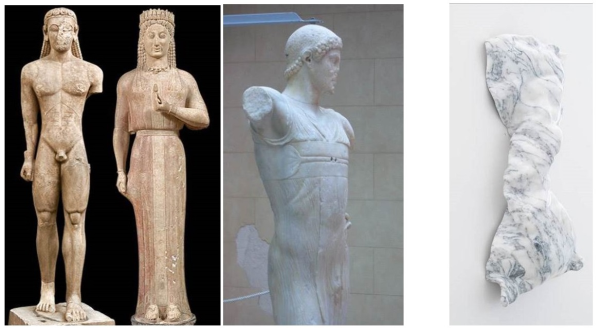
Fig. 1: Kouros (600 bc) and Kore (550-540 bc).
Fig. 2: Kouros VI century.
Fig. 3: Lynda Benglis, Torsos, 2020-21, Bianco Carrara marble, 140 x 60 x 25 cm approx.
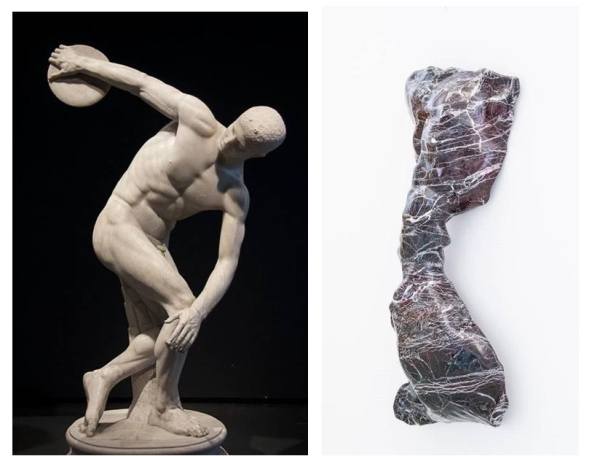 Fig. 4: Myron, Discobolus, Roman copy by original in bronze.
Fig. 4: Myron, Discobolus, Roman copy by original in bronze.
Fig. 5: Lynda Benglis, Torsos, 2020-21, Red of Levanto, 140 x 60 x 25 cm approx.
Furthermore, some of Benglis's marble works bear similarities to the armless Winged Victory of Samothrace [fig. 6] and Venus de Milo [fig. 7], exemplifying her familiarity with Greek art and its representation of idealized human figures [fig. 8].
Benglis's marble series showcases her knowledge of art history and ability to reinterpret ancient models in a contemporary and innovative manner.
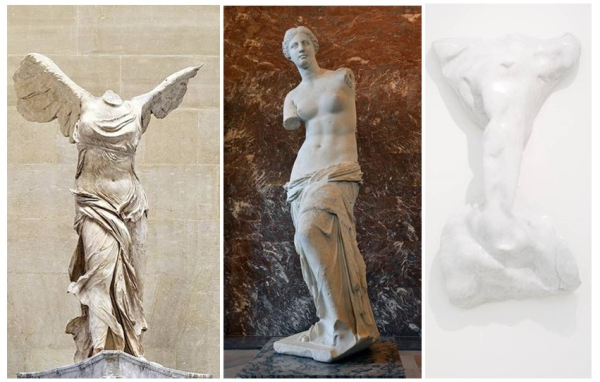 Fig. 6: Winged Victory of Samothrace, 200-190 b.C., Musée du Louvre, Paris, France.
Fig. 6: Winged Victory of Samothrace, 200-190 b.C., Musée du Louvre, Paris, France.
Fig. 7: Alexandros of Antioch, Venus de Milo, 130-100 b.C., Musée du Louvre, Paris, France.
Fig. 8: Lynda Benglis, Torsos, 2017-18, Bianco Carrara marble, 139x76x20cm approx.
Indeed, Lynda Benglis's large marble Torsos sculptures embody the culmination of a Greek sculptural tradition, presenting volumetric forms that command space and convey the expressive power and dynamism often associated with Baroque art. The choice of marble for these works is significant as marble has been a prominent material for sculpture since ancient times. Its continued use by contemporary artists reinforces its enduring significance. While white and pure marble is commonly associated with contemporary art, as seen in the works of artists like Sol Lewitt [fig. 9] with his marble, metal, and wood cubes, Benglis deviates from this convention by employing a variety of colors [Fig. 10 a, b, c]. The result is a range of shimmering shades, adding further depth and visual richness to her Torsos. By utilizing marble in different hues, Benglis introduces a contemporary twist to the material's traditional use, challenging expectations and expanding the possibilities of sculptural expression. Her experimentation with varied colors of marble demonstrates her innovative approach to historical references while pushing artistic boundaries.
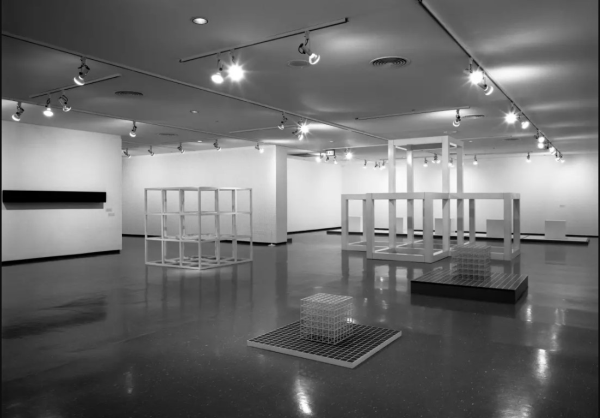 Fig. 9: Installation view of Sol LeWitt show in 1979, Museum of Contemporary Art Chicago, Photo: © MCA Chicago.
Fig. 9: Installation view of Sol LeWitt show in 1979, Museum of Contemporary Art Chicago, Photo: © MCA Chicago.
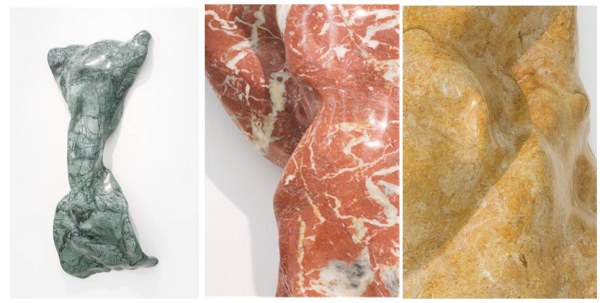 Fig. 10 a-b-c: Lynda Benglis, Torsos, 2017-18, Various marbles, 139 x 76 x 20 cm approx.
Fig. 10 a-b-c: Lynda Benglis, Torsos, 2017-18, Various marbles, 139 x 76 x 20 cm approx.
Lynda Benglis's Pleats and Wings series also reference a strong connection to the history of art by drawing inspiration from various sources. The Pleats series [fig. 12, 15], as well as the Wings series [fig. 13], exemplify these references. The draped forms in Benglis's Pleats series evoke the concept of "living" drapery, a characteristic often associated with the works of the ancient Greek sculptor Phidias. The dynamic folds and cascades of fabric seen in figure 12 and 15, for example, echo the aesthetic of the Caryatids [fig. 11] from the porch of the Erechtheion in Athens, are also renowned for their masterful depiction of drapery. Furthermore, Benglis's Pleats and Wings series possess a paradoxical sense of stillness within movement. This frozen physicality harkens back to earlier Italian artists that explored the possibility to represent the fluidity of drapery in the immutable material of marble. Leonardo da Vinci's studies of drapery [fig. 14] was able to capture the nuances and intricacies of fabric, in this challenging medium. In addition, the dynamic and emotional expressiveness found in Benglis's sculptures can be associated with the works of artists such as Niccolò dell'Arca, as depicted in figure 16. His "Lamentation over the Dead Christ" expresses an extreme dynamism that delivers an emotional impact. This Baroque reference is also quite evident in Benglis's works. The lyrical and theatrical qualities of the drapery can be compared to Gian Lorenzo Bernini's sculpture of Saint Teresa in Rome [fig. 17]. Bernini's piece captures a moment of divine ecstasy, utilizing dramatic drapery to heighten an overall theatricality and emotional intensity. By incorporating these art historical references, Benglis demonstrates her knowledge and understanding of the lineage of art, while reinterpreting and infusing it with her own vision she is having a dialogue between the past and the present.
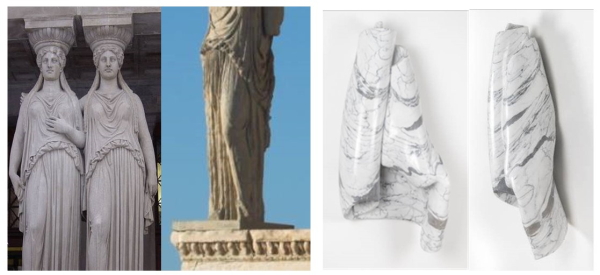 Fig. 11 a, b: Details of the Caryatid, Erechtheion, Athens, Greece.
Fig. 11 a, b: Details of the Caryatid, Erechtheion, Athens, Greece.
Fig. 12 a, b: Lynda Benglis, Untitled I, 2017-18, Bianco Carrara Marble, 120 x 50 x 45 cm approx.
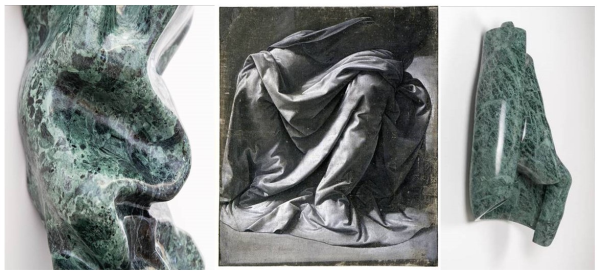 Fig. 13: Lynda Benglis, detail of Wing, 2020-2021.
Fig. 13: Lynda Benglis, detail of Wing, 2020-2021.
Fig. 14: Leonardo da Vinci, Study of drapery. 1470.
Fig. 15: Lynda Benglis, Untitled I, 2017-18, Green of Guatemala marble, 120 x 50 x 45 cm approx.
Lynda Benglis's sculptures, particularly in the Pleats and Wings series, are characterized by their ability to evoke a sense of life, energy, and presence. Benglis intended her sculptures to serve as vessels of vitality, encapsulating the essence of life within their abstract forms. Similar to the approach taken by Bernini in Rome, Benglis seeks to capture the intensity of a moment and freeze it in time.
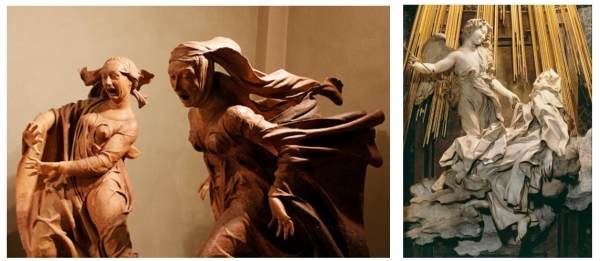 Fig. 16: Nicolò dell’Arca, Lamentation over the Dead Christ, 1463-90, clay.
Fig. 16: Nicolò dell’Arca, Lamentation over the Dead Christ, 1463-90, clay.
Fig. 17: Bernini, The Ecstasy of Saint Teresa, 1647-52, marble, life size measure.
In doing so, she combines beauty and extravagance, resulting in spectacular "frozen gestures" that invite permanent contemplation. These sculptures convey a range of emotions and themes, including the realization of mortality, the elation of potential salvation, mysticism, and eroticism. The Knots series [fig. 18 a, b, c] draws inspiration from Greek everyday life, specifically referencing the knots used by fishermen and sailors, as well as the unique bulbous shape of Greek cookies. These works showcase Benglis's ability to incorporate elements of Greek culture and tradition into her sculptures, highlighting a different aspect of her artistic exploration.
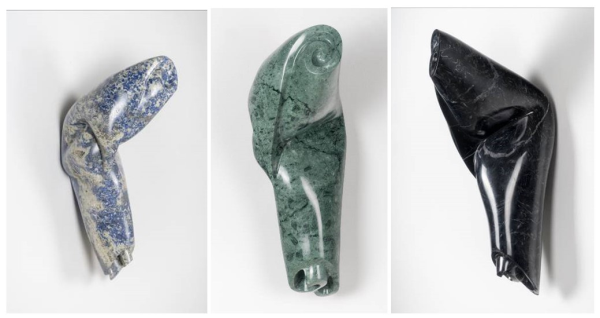 Fig. 18 a, b, c: Lynda Benglis, Untitled II, 2017-18, various colors.
Fig. 18 a, b, c: Lynda Benglis, Untitled II, 2017-18, various colors.
When Lynda Benglis embarked on creating her pleated works, she initially used a wire screen as a base, which she then covered in gold leaf and subsequently sprayed with liquid metals [fig. 20, 21]. However, she quickly expanded her exploration to encompass a wide range of materials, both traditional and unconventional. This diverse range includes classical materials such as paper, gesso, and marble, as well as more unusual ones like polyurethane. Benglis found inspiration for her pleated works in various sources. Gilded Orthodox icons, renowned for their intricate and decorative nature, served as one of her initial points of reference [fig. 19].
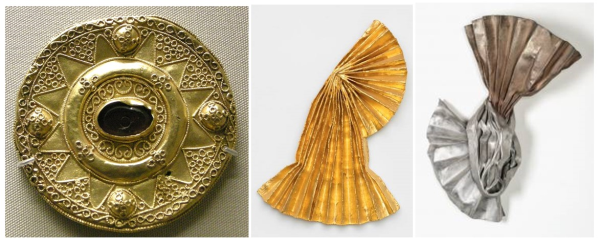
Fig. 19: Example of Lombard Goldsmith Art.
Fig. 20: Lynda Benglis, Fandango, 1979, brass screening, plaster, gesso, oil base, gold leaf, 91.4 x 61 x 7.6 cm.
Fig. 21: Lynda Benglis, Dorado, 1972, aluminum over bronze mesh, 91 x 63 x 20 cm approx.
The ornamental art of Lombard goldsmiths also influenced her exploration of texture and surface treatment. Furthermore, Benglis drew inspiration from Paleochristian and Byzantine art, which are known for their richly adorned and intricate depictions. These artistic traditions often featured elaborate draperies and folds, reminiscent of the marble draperies depicted in figure 11. In addition to these historical references, Benglis also incorporated elements from flora and fauna paintings into her pleated works. This infusion of organic motifs further contributes to the dynamic and visually captivating nature of her sculptures. By integrating these diverse influences, ranging from gilded icons to ancient draperies and natural imagery, Benglis creates a multi-layered visual language within her pleated works. Her exploration of materials and sources reflects her ability to blend historical references with contemporary experimentation, resulting in sculptures that are both rooted in tradition and infused with her own artistic vision.
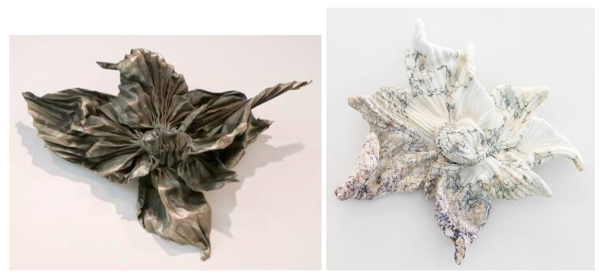 Fig. 22: Lynda Benglis, Scarab, 1990, Stainless steel mesh and aluminum, 132 x 190 x 40,6 cm
Fig. 22: Lynda Benglis, Scarab, 1990, Stainless steel mesh and aluminum, 132 x 190 x 40,6 cm
Fig. 23: Lynda Benglis, Brooch, 2020-2021, Breccia di Seravezza marble, 120 x 98 x 20 cm approx.
The presence of radial shapes in certain sculptures of Lynda Benglis's Pleats series, as depicted in figures 22 and 23, indeed carries ancient origins and significant symbolism. In Roman Antiquity, the radial shape held a specific meaning as it was associated with Apollo, the God of the Sun [fig. 24, 26]. This connection to the pagan symbolism of the sun and its radiance was later adopted by early Christian art, where it came to represent Jesus. The adoption of pagan symbols into early Christian art was a common practice, allowing for the assimilation and reinterpretation of existing cultural and religious motifs. The radial shape, with its association to Apollo and the sun, took on a new significance in Christian iconography, representing the divine light and glory of Jesus Christ. This symbol continues to be used in religious artifacts today, particularly in monstrances or ostensoriums [fig. 25].
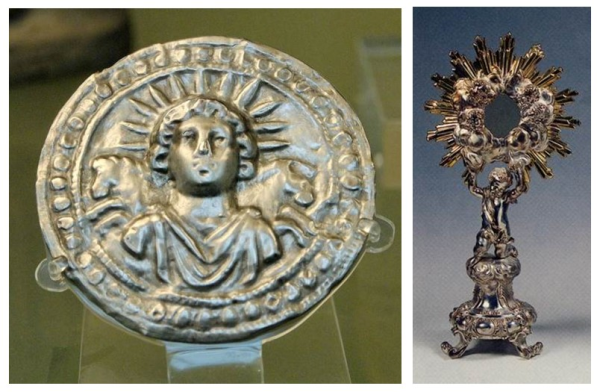 Fig. 24: Sol Invictus, III century b.C.
Fig. 24: Sol Invictus, III century b.C.
Fig. 25: Ostensorium, Museo dell’Opera Prato, Italy.
A monstrance is a sacred vessel used in the Catholic Church to display the consecrated Eucharist, with the radiant shape serving as a visual representation of the divine presence. By incorporating the radial shape in her sculptures, Benglis not only taps into the rich historical and cultural associations of the symbol but also allows for its reinterpretation and contemporary resonance. The use of such symbolism adds layers of meaning to her works, inviting viewers to explore the intersections of ancient and modern, religious and secular, and the ongoing power and significance of symbolic representations.
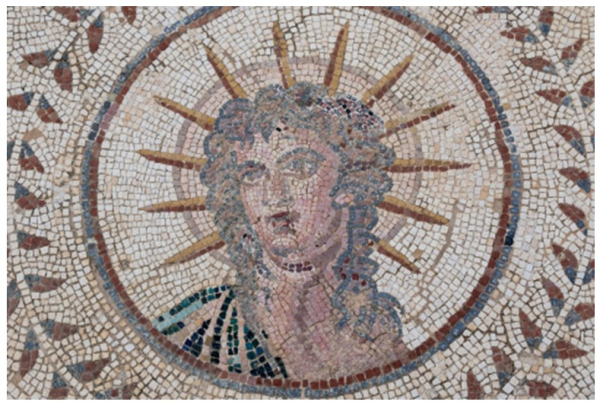 Fig. 26: Sol Invictus, Roman mosaic, archeological site, Santiponce, Spain.
Fig. 26: Sol Invictus, Roman mosaic, archeological site, Santiponce, Spain.
Lynda Benglis's Pleats series demonstrates her exceptional ability to engage with ancient models, internalize them, and reimagine them in a pioneering and contemporary manner. In this series, Benglis explores the dynamic forces of movement within sculptural forms, capturing a sense of frozen intensity similar to the approach taken by Bernini. The sculptures in the Pleats series embody beauty and extravagance, merging these qualities into spectacular "frozen gestures" that invite viewers to engage in permanent contemplation. Benglis's attention to materials and her continuous pursuit of the "extravagant" have led her to choose marble as her primary material in recent years. By using marble, she expands the boundaries of sculpture and introduces vibrant colors into her wall works, challenging the monotone palette often associated with Minimalism. Benglis's incorporation of brightly colored marble sculptures provides a lively contrast to the minimalistic aesthetic, which she has sought to overcome throughout her artistic career. By pushing the boundaries of sculpture and embracing vibrant hues, she infuses her works with energy, expression, and a sense of visual vibrancy. Through her exploration of materials and her desire to transcend artistic conventions, Benglis's Pleats series represents a bold and innovative approach to sculpture. By integrating ancient models and reinterpreting them in a contemporary context, she creates works that are simultaneously rooted in tradition and forward-thinking in their artistic expression.
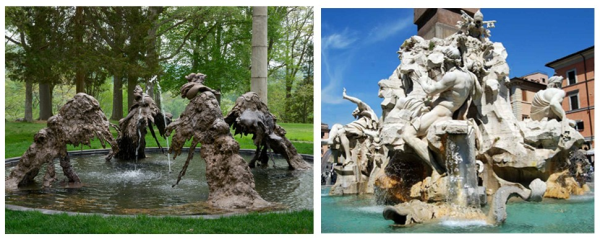 Fig. 27: Lynda Benglis, North, South, East, West Fountain, Storm King Center, New York.
Fig. 27: Lynda Benglis, North, South, East, West Fountain, Storm King Center, New York.
Fig. 28: Bernini, Fontana dei Quattro Fiumi, Rome, Italy.
Lynda Benglis's works indeed exhibit parallelisms and references to the masterpieces of Gian Lorenzo Bernini, one of the most influential sculptors of the Baroque period. The dynamism of figures and draperies seen in Benglis's works, particularly in relation to the Ecstasy of Saint Teresa, draws comparisons to Bernini's mastery of capturing movement and creating dramatic compositions. Additionally, Benglis's North, South, East, West Fountain, made of bronze and steel and located at the Storm King Art Center [fig. 27] can be seen as a contemporary interpretation of Bernini's Fontana dei Quattro Fiumi (Fountain of the Four Rivers) in Piazza Navona, Rome [fig. 28]. Both sculptures incorporate water features and monumental scale, emphasizing the interplay between sculpture and its surrounding environment. Furthermore, Benglis's bronze Cloak-Wave Pedmarks [fig. 29], demonstrate a similarity to the theatricality and extreme linearity of Bernini's Tomb of Pope Alexander VII, [fig. 30]. The way in which the drapery is sculpted and the sense of movement created in both artworks contribute to the dramatic impact and visual interest. By referencing and reinterpreting Bernini's masterpieces, Benglis engages in a dialogue with art history while bringing her own contemporary perspective to the table. Through these connections, she pays homage to the legacy of Bernini and his contributions to the field of sculpture, while exploring new possibilities and pushing the boundaries of her own artistic practice.
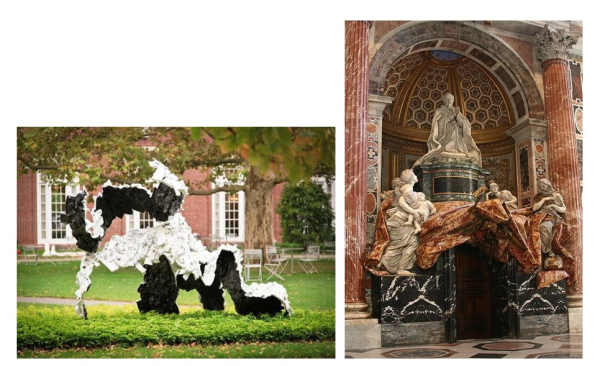 Fig. 29: Lynda Benglis, Cloak-Wave Pedmarks, 1998, bronze with black-and-white patina, 217.2 x 218.4 x 142.2 cm
Fig. 29: Lynda Benglis, Cloak-Wave Pedmarks, 1998, bronze with black-and-white patina, 217.2 x 218.4 x 142.2 cm
Fig. 30: Bernini, Tombe of Pope Alexander VII, 1671-78, Rome, Italy.
You are correct in noting the influence of the Italian Baroque school, particularly the works of Bernini, in Lynda Benglis's marble sculptures from the Pleats series. Figure 31 exemplify the unconventional and intricate forms that can be seen in the Italian Baroque tradition. These sculptures, originally conceived as miniature fountains that can be hung on a wall, capture the essence of the Baroque aesthetic with their dynamic shapes and intricate details. The reference to Bernini's Tomb of Pope Alexander VII [fig. 30], becomes apparent through the multitude of colors present in Benglis's marble works. This chromatic variety enhances the visual impact and liveliness of the sculptures, echoing the vibrant hues found in Bernini's masterpiece. By drawing inspiration from Bernini's innovative use of color and form, Benglis not only pays homage to the Italian Baroque tradition but also infuses her own contemporary sensibilities into her sculptures. The incorporation of diverse colors adds a layer of complexity and visual interest to her works, creating a unique and captivating aesthetic experience. Benglis's ability to reinterpret and reimagine the influences of the Italian Baroque, particularly Bernini's work, showcases her deep understanding of art history and her skill in translating those influences into her own artistic language.
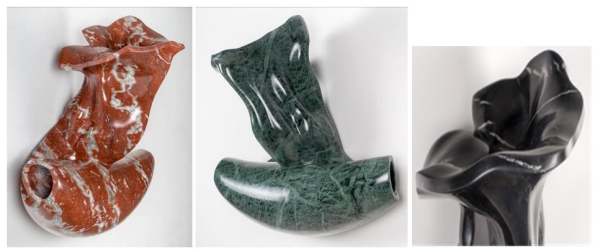 Fig. 31: Lynda Benglis, Untitled III, 2017-18, various marble colors.
Fig. 31: Lynda Benglis, Untitled III, 2017-18, various marble colors.
Lynda Benglis's recent Wings series [fig. 34] takes an interesting approach by allowing the individual sculptures to be installed on a wall as a group of three. This installation method creates a visual continuity and establishes a connection between the individual works. By arranging these sculptures together, Benglis inscribes her marble works into an iconographical research centered around the concept of the Ancient trio of the Graces [fig. 32, 33].
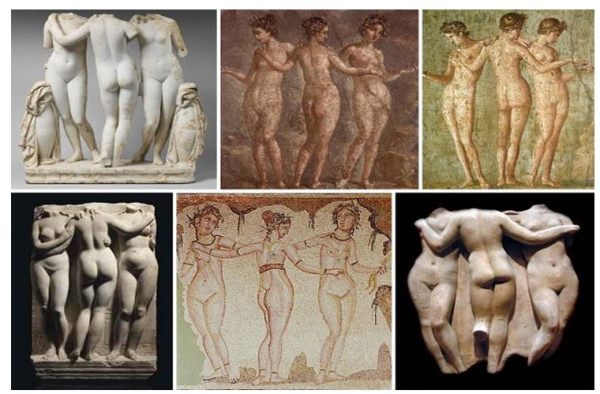 Fig. 32: Iconography of the Three Graces.
Fig. 32: Iconography of the Three Graces.
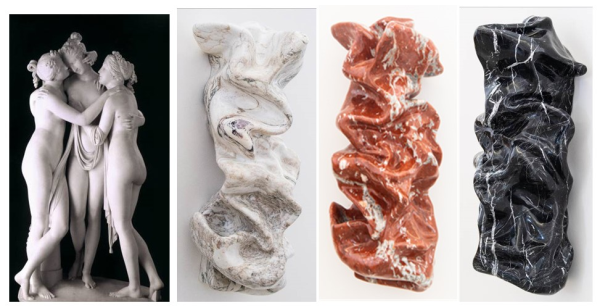 Fig. 33: Antonio Canova, The Graces, 1812-1817, marble, 17 x 97 x 57 cm.
Fig. 33: Antonio Canova, The Graces, 1812-1817, marble, 17 x 97 x 57 cm.
Fig. 34: Lynda Benglis, Wing, 2020-21, various marble, 98 x 42 x 35 cm approx.
The Graces, also known as the Three Graces or Charites in Greek mythology, were often depicted as a trio of goddesses associated with charm, beauty, and gracefulness. Benglis's exploration of the Graces theme can be traced back to her monumental sculpture The Graces [fig. 35]. This work serves as an initial point of reference for her investigation into the iconography and symbolism of the Graces. Continuing her exploration, Benglis incorporates the extravagant Pink Lady [fig. 36] into this iconographical research. This work further expands the representation of the Graces, taking it to a more contemporary and unconventional realm. By referencing the Ancient trio of the Graces and incorporating it into her marble works, Benglis engages in a dialogue with classical art and mythology while infusing her own unique interpretation and contemporary expression. The installation of the Wings series in a group of three highlights the interconnectedness and continuity of her exploration of these themes, creating a visually striking and conceptually rich experience for viewers.
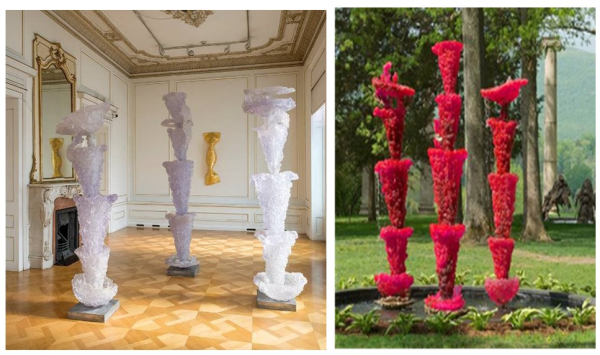 Fig. 35: Lynda Benglis, The Graces, 2003-05, Installation View at Museum of Cycladic Art, Athens, 2019. Courtesy of Museum of Cycladic Art, Athens.
Fig. 35: Lynda Benglis, The Graces, 2003-05, Installation View at Museum of Cycladic Art, Athens, 2019. Courtesy of Museum of Cycladic Art, Athens.
Fig. 36: Lynda Benglis, Pink Lady, 2014. Installation View of Water Sources, 2015, Storm King Art Center, New Windsor, USA.
Indeed, Lynda Benglis's marble sculptures exhibit a remarkable sense of lightness and delicacy, despite the inherent weight of the material. This quality draws parallels to Bernini's works, where the marble draperies appear to gracefully dance in space, defying their materiality. Benglis's wise and skillful use of different colored marbles, along with the varied textures of each material, adds depth and nuance to her sculptures. This emphasis on sinuous shapes and meticulous details enhances the overall seductive and captivating appearance of her artworks, giving them a sense of physical presence and an extraordinary "movement of soul." Benglis has succeeded in achieving an innovative, colorful, and dynamic representation of forms in motion, extending and filling the surrounding space. Through her sophisticated mastery of marble techniques, Benglis highlights the material's inherent qualities and flawlessly molds her sculptures. The Torsos, Pleats, Wings, and Knots marble series encompass the entire spectrum of art history. They incorporate elements from Greek and Roman research on the human body and movement, the perfection of the Renaissance period, the dynamic energy of Mannerism, and, most notably, the grandeur and emotionally charged compositions of the Baroque. By encompassing these historical references and artistic movements within her marble works, Benglis demonstrates her profound understanding of art history while pushing its boundaries with her own contemporary vision. Her sculptures not only pay homage to the past but also contribute to the ongoing dialogue between tradition and innovation in the realm of marble sculpture.
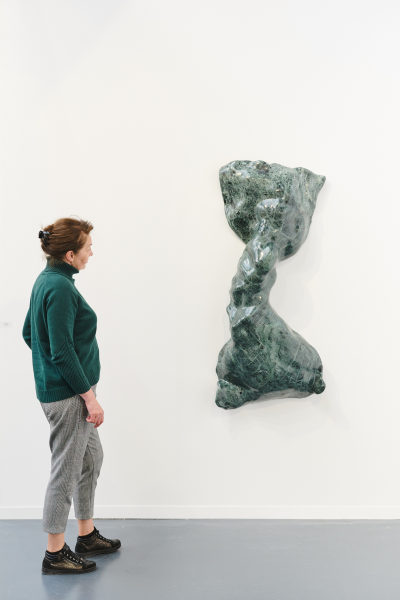 Fig. 37: Lynda Benglis, Untitled (Torsos), 2020-2021, Green of Guatemala marble, 140 x 60 x 25 cm.
Fig. 37: Lynda Benglis, Untitled (Torsos), 2020-2021, Green of Guatemala marble, 140 x 60 x 25 cm.
Bibliography:
F. Gautherot, C. Hancock, S. Kim, Lynda Benglis, cat. exhibition, Les presses du reel, France, 2009-2011, P.140-146
J.P. Stern, N.R. Lawrence, Lynda Benglis: Water Sources, cat. exhibition, Storm King Art Center, New York, 2015.
S. Richmond, Lynda Benglis: Beyond Process, I.B Tauris, New York, 2013.